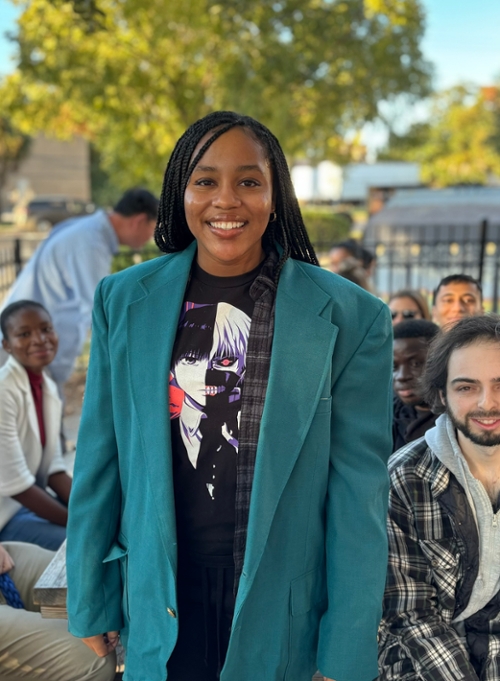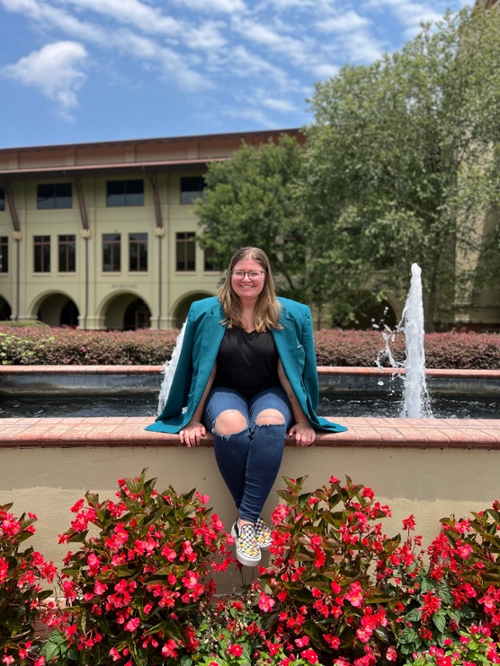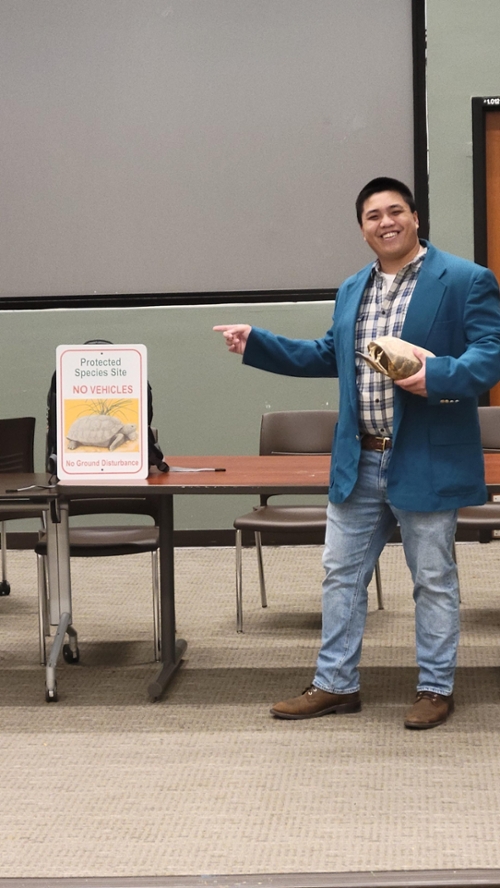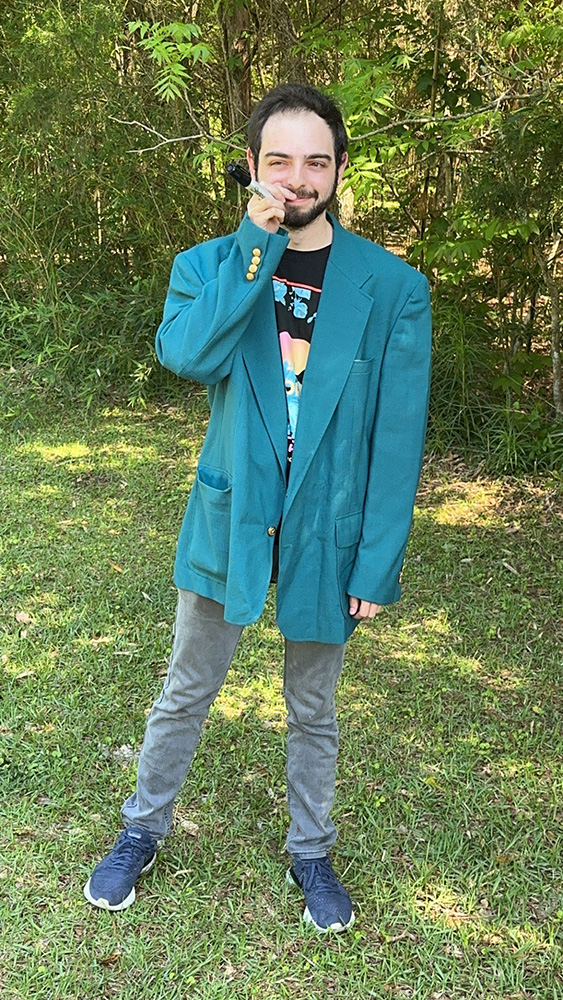New Biology Graduate Students Alumni
New Biology Graduate Students Alumni
Summer 2024
Non-Thesis Graduates
|
Photo of Student
|
Name of Student:
|
Faculty Advisor(s): |
|
Last Name, First Name MI. |
Name Name |
|
|
Photo of Student
|
Name of Student:
|
Faculty Advisor(s): |
|
Last Name, First Name MI. |
Name Name |
Thesis Graduates
|
|
Name of Student: |
Faculty Advisor(s): |
|
Rincon Diaz, Daniel |
Dr. Ansul Lokdarshi |
|
|
Title of Abstract Methyl jasmonate stress signaling in Arabidopsis thaliana functions via reactive oxygen species to activate the GCN2-eIF2α module |
||
|
Abstract: Plant growth and productivity rely on rapid energy management strategies designed to cope with dynamic environmental conditions (e.g., fluctuating light intensities, temperature, humidity, and pathogen interactions). Previous work by Lokdarshi et al., identified a novel fast-regulatory switch in Arabidopsis thaliana that functions at the nexus of two fundamental energy management programs, cytosolic translation and reactive oxygen species (ROS) signaling. The work showed that the General Control of Nonderepressible 2 (GCN2), a cytosolic serine/threonine protein kinase, is rapidly activated in response to ROS emanating under a variety of abiotic, biotic, and xenobiotic stresses. GCN2 then phosphorylates its target, α-subunit of the eukaryotic translation initiation factor (eIF)2, resulting in readjustments to the active protein synthesis as a plausible mode for stress remediation. In the work presented here, we test the hypothesis that the biochemical, molecular and physiological responses of the Arabidopsis GCN2-eIF2α module towards the plant defense hormone, methyl jasmonate (MeJA) is regulated by light and ROS. We show that eIF2α phosphorylation (P-eIF2α) as proxy for GCN2 activation under MeJA stress requires light and this activation can be mitigated with antioxidants and photosynthetic inhibitors. At the physiological level, gcn2 mutant seedlings show increased sensitivity towards MeJA stress in a primary root growth assay. Interestingly, gcn2 mutant shows similar rate of protein synthesis as the wild-type under MeJA stress as evidenced by polysome profiling and puromycin incorporation assay. Taken together, we show the conservation of Arabidopsis GCN2-eIF2α activation by ROS during methyl jasmonate stress. |
||
|
Photo of Student |
Name of Student:
|
Faculty Advisor(s): |
|
|
Last Name, First Name MI. |
Name Name |
|
Title of Abstract Here |
||
|
Abstract: Here Here |
||
Spring 2024
Non-Thesis Graduates
 |
Name of Student: |
Faculty Advisor(s): |
|
Bella, Adrienne L. |
Dr. Theodore A. Uyeno
|
Thesis Graduates
 |
Name of Student: |
Faculty Advisor(s): |
|
Taylor, Kenyanna N. |
Dr. Emily Cantonwine |
|
|
Title of Abstract Comparing the effects Sulfur Synthetic Fungicides Mixtures on Leaf Spot and Rust Peanut Pathogens |
||
|
Abstract: Early and late leaf spot, caused by the fungi Passalora arachidicola and Nothopassalora personata, are important foliar diseases of peanut that can lead to premature defoliation and yield loss if not controlled. In fields with a history of leaf spot, the diseases are managed using frequent applications of fungicides. Recently, mixtures of micronized elemental sulfur with tebuconazole, a demethylation inhibitor (DMI) fungicide, or azoxystrobin, a quinone outside inhibitor (QOI) fungicide,were shown to lessen defoliation caused by leaf spot. The objective of this study was to determine if sulfur mixtures reduce defoliation by causing fewer leaf spot infections or byincreasing plant tolerance. Field studies conducted at the University of Georgia Coastal Plain Experiment Station in 2020 and 2021 exposed peanut plants to 7 applications of six fungicide treatments at recommended rates: (1) a nontreated control, (2) sulfur, (3) tebuconazole (DMI), (4) DMI + sulfur, (5) axozystrobin (QoI), and (6) QoI + sulfur. Disease was assessed weekly between 90 and 140 days after plating (dap) using the FL 1-10 scale, a visual estimation of defoliation and disease severity, and as the number of leaflets with leaf spot (leafletincidence) and the mean number of lesions per leaflet (leaflet severity) for 10 lateral branches per plot. As expected, defoliation assessments were significantly lower for the sulfur mixture treatments than the DMI and QoI treatments alone in most cases (P<0.05). A similar pattern was observed for leaflet incidence and leaflet severity (P<0.05). There was a significant exponential relationship between cumulative leaflet severity(AUDPC severity) and final defoliation (R2 = 0.77; P<0.001) and AUDPC severity and AUDPC defoliation (R2 = 0.82; P<0.001). In most cases, sulfur effects on defoliation were insignificant when AUDPC severity was included as a covariate in the model (P>0.05). This suggests that the mechanism of reduced defoliation is due to fewer leaf spot infections rather than increased plant tolerance. Additional studies were conducted to evaluate the effects of sulfur mixtures on rust disease, caused by Puccinia arachidis, under field conditions, and on the growth of N. personta in culture. Sulfur mixtures did not significantly improve rust severity compared to the DMI and QoI alone (P>0.05). Results from the in vitro study suggests that sulfur mixtures did not significantly reduce germination compared to the DMI and QoI treatments alone (P=0.14) but may reduce hyphal branching(P<0.05). However, treatment effects on germtube number and total hyphal growth were inconsistent across the two experiments. More research is needed to determine if the mechanism for reduced infections is the result of increased toxicity to the fungus. |
||
Fall 2023
Non-Thesis Graduates
(None)
Thesis Graduates
|
|
Name of Student:Faculty Advisor(s): |
|
|
Le, Christopher |
Dr. J. M. Lockhart |
|
|
Title of Abstract Survival assessment and movement analysis of gopher tortoises (Gopherus polyphemus) in south Georgia, USA |
||
|
Abstract: The keystone and threatened status of the gopher tortoise (Gopherus polyphemus) makes them a species of interest for wildlife management. Two studies were conducted on gopher tortoises in south Georgia. The first study assessed the survivability of 174 passive integrative transponder (PIT) tagged gopher tortoise hatchlings released in 2008 and 2009 at Reed Bingham State Park (RBSP), Cook County, Georgia, USA. It was hypothesized that 10% (17/174) would be recaptured. From March 2020 to July 2021, release sites Gopher Tortoise Management Area and Pioneer Site were surveyed. Zero (N = 0) of the 174 PIT-tagged hatchling tortoises were recaptured. Suggestions for recapture failure were predation, human presence, detection difficulty, dispersal away from release sites, and Upper Respiratory Tract Disease. The second study analyzed movement activity of an adult male gopher tortoise utilizing Global Positioning System (GPS) technology at Moody Air Force Base, a military installation in Lowndes and Lanier Counties, Georgia. Movement was GPS-tracked from September 2020 to January 2021. GPS data contained location, temperature, and satellite-specific acquisition information. A total of 263 (N = 263) Fixed Locations (FL) were acquired. FL were analyzed for home range, core area, distance >300 m, and nocturnal movement (20:00 – 05:00). Home range increased 10-fold with increasing horizontal dilution of precision (HDOP) (range: 3.55 – 15.86 ha, HDOP ≤ 1.5 – 9.9), core area was 0.13 ha, greatest straight-line distance was 345 m, and 41 nocturnal events occurred. GPS unit troubleshooting and gopher tortoises’ fossorial nature attributed to early battery life depletion and FL accuracy and precision analysis. Most FL occurred in the core area; long distance movement outside the core area was exhibited five times, one included nocturnal movement. Suggestions for long distance movement were habitat quality, overwinter burrowing, reproduction, social interaction, and energy expenditure recovery. |
||
Summer 2023
Non-Thesis Graduates
 |
Name of Student: |
Faculty Advisor(s): |
|
Hector, Jaelle |
Dr. James Nienow |
|
(Photo Not Avaialble) |
Name of Student:
|
Faculty Advisor(s):
|
|
Mgbeahuruike, Miracle O. |
Dr. Christina Calestani
|
Thesis Graduates
|
|
Name of Student: |
Faculty Advisor(s): |
|
Castellano, Damion A. |
Dr. Emily Cantonwine | |
|
Title of Abstract Comparing Nothopassalora personata pre-infection development, colonization, and haustorial characteristics between susceptible and resistant peanut genotypes. |
||
|
Abstract: Nothopassalora personata is the fungal causative agent of late leaf spot in peanut and causes premature defoliation if not controlled. N. personata is a hemi-biotroph that uses specialized hyphae called haustoria to take nutrients from the plant cells during the biotrophic phase. A new method was developed to characterize haustoria associated with lower epidermal cells of peanut leaves. Phenotypes related to resistance were measured including, the distance of the farthest haustoria from the edge of the lesion, the distance of the farthest colonizing hyphae, number of haustoria per unit area, and size of haustoria. The susceptible genotype had significantly fewer haustoria per unit area in the larger lesions, but not in the smaller lesions. Colonizing hyphae extended farther in the susceptible genotype in larger lesions. |
||
 |
Name of Student: |
Faculty Advisor(s): |
|
Holley, Amber N. |
Dr. Eric Chambers Dr. Mark Blackmore Dr. J. M. Lockhart Dr. Erin Grabarczyk |
|
|
Title of Abstract Disease Surveillance of Dirofilaria immitis and West Nile Virus in Mosquitoes in Lowndes County, Georgia |
||
|
Abstract: Dirofilaria immitis, the causative agent of canine heartworm disease, and West Nile virus (WNV) are both mosquito-borne pathogens. Mosquito surveillance and vector determination are crucial in understanding the transmission of these pathogens which helps implement methods of control to prevent and predict outbreaks. In this study I assessed the ability of the Anopheles quadrimaculatus complex to transmit D. immitis and investigated the influence climate and land use and land changes (LULC) have on WNV transmission in Culex quinquefasciatus mosquitoes, the primary vector in the Southeastern United States. Standard PCR and an L3-specific RT-PCR protocol were used to assess D. immitis infection rates in An. quadrimaculatus mosquito samples. To determine the influence of climate and LULC on WNV from 2012-2021, data were collected from Weather Underground and the VSU WNV Mosquito Surveillance lab. Results from this study suggest that the An. quadrimaculatus complex is a potential vector of D. immitis and that urbanization and temperature influence WNV transmission by mosquitoes in Lowndes Co., GA. |
||
Department of Biology
-
Room 2035, 2nd Floor
Bailey Science Building -
Mailing Address
1500 N. Patterson St.
Valdosta, GA 31698 - Phone: 229.333.5759
- Fax: 229.245.6585
Monday - Thursday
8:00AM until 5:30PM
Friday
8:00AM until 3:00PM
Saturday - Sunday
Office Closed


